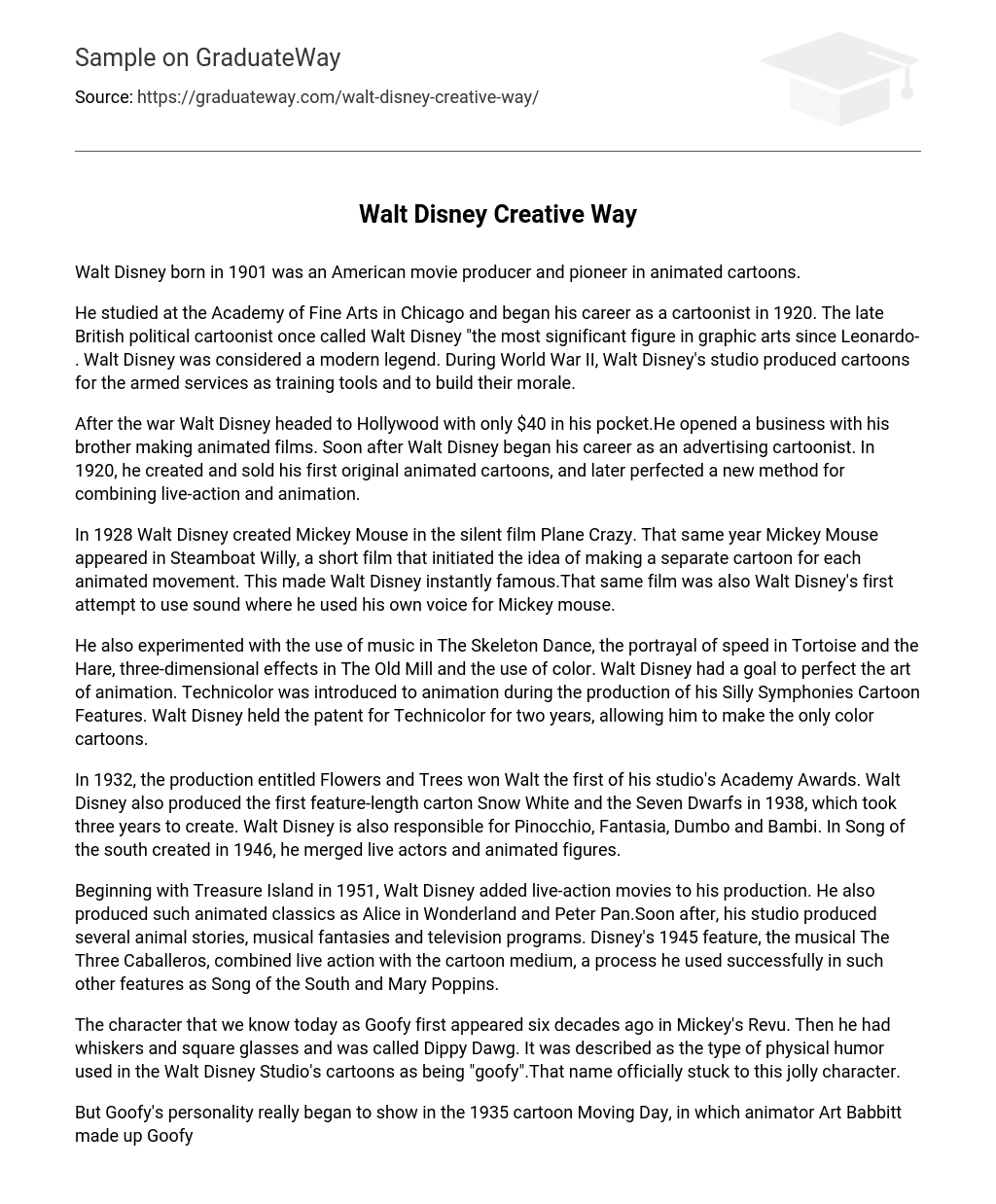Walt Disney, an American movie producer and pioneer in animated cartoons, was born in 1901.
Walt Disney, who graduated from the Academy of Fine Arts in Chicago, began his career as a cartoonist in 1920. He was widely recognized and praised by a British political cartoonist as “the most significant figure in graphic arts since Leonardo,” establishing himself as a legendary artist of his time. During World War II, Disney’s studio produced cartoons for the armed services with the purpose of aiding in training and uplifting morale.
After the war, Walt Disney moved to Hollywood with only $40 in his possession. He partnered with his brother to establish a business in creating animated films. Shortly after, Walt Disney embarked on his journey as an advertising cartoonist. In 1920, he successfully produced and sold his first original animated cartoons. Furthermore, he later developed an innovative technique for integrating live-action and animation.
In 1928, Walt Disney introduced Mickey Mouse to the world in the silent film Plane Crazy. It was in that same year that Mickey Mouse made his appearance in Steamboat Willy, a short film that revolutionized the concept of creating individual cartoons for each animated movement. This innovation catapulted Walt Disney to instant fame. Additionally, Steamboat Willy marked Disney’s initial foray into incorporating sound, with Disney lending his own voice to Mickey Mouse.
Walt Disney was an innovative animator who explored various techniques in his films. He incorporated music into The Skeleton Dance, depicted speed in Tortoise and the Hare, created three-dimensional effects in The Old Mill, and experimented with color. In his pursuit of perfecting the art of animation, Disney introduced Technicolor to his Silly Symphonies Cartoon Features. He even held the patent for Technicolor, enabling him to produce the only color cartoons at that time.
Walt Disney had a successful career in animation. His film Flowers and Trees won the studio’s first Academy Award in 1932. He then created Snow White and the Seven Dwarfs, which was the first full-length cartoon that took three years to complete. Moreover, Walt Disney was responsible for bringing Pinocchio, Fantasia, Dumbo, and Bambi into existence. In 1946, he combined live actors with animated characters to make Song of the South.
From 1951, Walt Disney began including live-action movies, starting with Treasure Island. He also created beloved animated films like Alice in Wonderland and Peter Pan. Additionally, his studio produced various animal stories, musical fantasies, and television shows. Disney’s 1945 production, the musical The Three Caballeros, was a combination of live-action and animation, a technique he successfully employed in other films like Song of the South and Mary Poppins.
Originally known as Dippy Dawg, the character we now recognize as Goofy made his debut sixty years ago in Mickey’s Revu. Sporting whiskers and square glasses, this jolly character was referred to as “goofy,” a term that represented the physical humor commonly employed in Walt Disney Studio’s cartoons. Subsequently, this name became the official moniker associated with this beloved character.
However, Goofy’s personality truly came to light in the 1935 cartoon Moving Day, thanks to animator Art Babbitt’s creation of Goofy’s role and the depth he brought to the character.
Disney was an innovator in television programming, starting production in 1954 and being one of the first to offer full-color programming with his Wonderful World of Color in 1961. The Mickey Mouse Club and Zorro were beloved favorites during the 1950s.
Throughout his life, Walt Disney and his productions earned numerous awards, including Academy Awards, for his tireless work and dedication.
Despite his death, the Disney studios continued to prosper and grow, ultimately attaining immense triumph. In the early 1980s, they initiated the production of films targeted towards mature viewers. Walt Disney, the genius behind Mickey Mouse, founded Disneyland and Walt Disney World Theme Park. Furthermore, Disneyland parks were also inaugurated in places like Tokyo and Marne-la Vallee, close to Paris.
Walt Disney expressed a strong desire to establish the California Institute of the Arts prior to his death on December 15, 1966. His goal was to create an educational institution at the college level that would nurture talent in various creative and performing arts disciplines. This institute held great importance for him as he saw it as a lasting legacy. In 1961, the merger between two schools, namely the Los Angeles Conservatory of Music and Chouinard Art Institute, led to the establishment of the California Institute of the Arts.
Walt Disney had a vision for a school that would bring together different forms of performing and creative arts in a one-of-a-kind approach to professional arts education. As an iconic and beloved figure from the 20th century, Disney became known globally for representing imagination, optimism, and individual accomplishment in American culture. His influence on the emotions, ideas, and spirits of countless Americans exceeded that of any other person from the previous century.
Through his work, he brought joy, happiness, and a universal means of communication to people from all nations.





